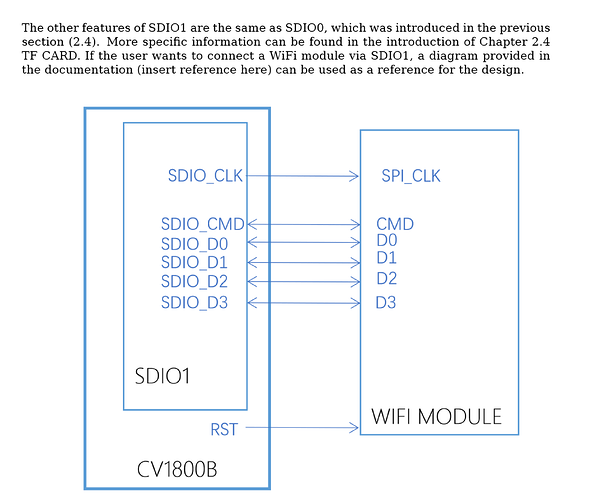The datasheet mentions sdio wifi support in chapter 2.5.3 SDIO1. And states that multiple Wi-Fi modules are confirmed to work with the duo. However the information on this is not clear. Here are some of my questions:
- Which pin is the
RST pin on the duo?
- Which pin is the
RST pin connected to on the Wi-Fi module? I assume it should be the WL_DIS# pin.
- In the dts files, wifisd is first defined in
cv180x_base.dtsi labeled disabled. And later removed in cv180x_asic_qfn.dtsi. Does this mean that sdio1 is not enabled? If so, what changes are needed to enable it properly?
Thanks.
duo的数据表里提到了对sdio wifi模块的支持(2.5.3 SDIO1),并且提供了若干duo支持的wifi模组的信息。但是数据表里对这块的描述比较模糊,对此我有以下几点疑问:
RST是duo上面的哪个管脚?RST连接的是wifi模组的哪个管脚?我猜测是WL_DIS#,但是不确定是否正确。cv180x_base.dtsi 里面定义了wifisd,但是标记为了disabled。随后引入的cv180x_asic_qfn.dtsi 里使用/delete-node/ wifi-sd@4320000;删掉了wifisd。这是否说明sdio1其实没有使能?如果是的话,应该如何修改dts文件来正确的使能?
谢谢!
Found something interesting. Still reading though.
wifi_pin {
compatible = "cvitek,wifi-pin";
poweron-gpio = <&porte 2 GPIO_ACTIVE_HIGH>;
wakeup-gpio = <&porte 6 GPIO_ACTIVE_HIGH>;
};
In the final dts file. Wi-Fi-pin is defined as above. But which pins are porte2 and porte6? According to the chip’s datasheet, porte seems to be RTCSYS_GPIO. But the pinout does not label this way. Is it the PWR_GPIO? I am so lost here.
edit: By comparing the address, I can confirm port e is RTCSYS_GPIO / PWR_GPIO / unlabeled GPIO group on duo. The strange thing here is: both port e 2 and port e 6 is absent on the exposed pins.
I am interested in wifi interface for Milk-V Duo.
According to the pin assignment of milk-V Duo, we can know which GPIOs are SDIO pins.
The pin assign for SDIO is as follows.
SDI_GP1 - GP2
SD1_GP0 - GP3
SD1_D2 - GP4
SD1_D1 - GP5
SD1_CLK - GP6
SD1_CMD - GP7
SD1_D0 - GP8
SD1_D3 - GP9
duo-pinout.webp (5760×1671) (milkv.io)
